
The Big Bang
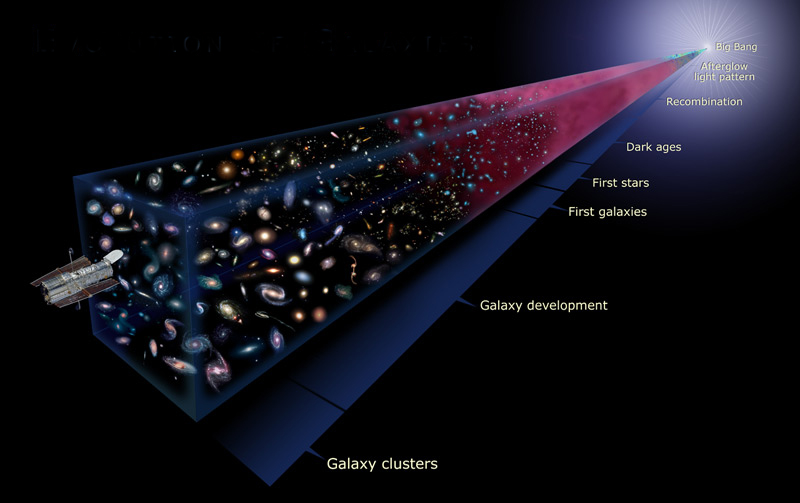
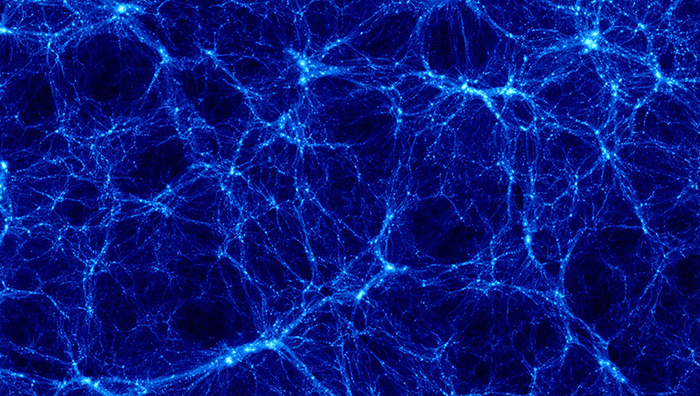
We use computer simulations to model the Big Bang. The above image was taken from a simulation of the cold dark matter model of the universe, a few billion years after the Big Bang event. The scale of the image is about a billion light years across. Small fluctuations in the dark matter cause the growth of gravitational instabilities The intersections of these giant filaments will form dark matter halos which will provide birth places for galaxies.
What was the early universe like? We infer what it must have been like from the fluctuations in the cosmic microwave background radiation and the large scale structure of the universe. Details of the large scale structure indicate that large filaments were important in the early stages of the universe, growing out of quantum mechanical fluctuations. We can't experiment with an early universe to find out if our expectations are correct, but we can build computer simulations, beginning with fundamental laws of physics. The simulations must be extremely high resolution to capture the behavior of large scale evolution, requiring considerable time on supercomputers.
The Millenium Simulation was performed by an international consortium of cosmologists, simulating the evolution of the universe using fundamental principles of physics to follow the dark matter distribution to condense normal matter into the eventual construction of galaxies and the present large scale structure of the universe. The largest simulation of its time, the Millenium I simulation used 1010 particles in its simulation, while the Millenium II improved on this resolution considerably.
This computer model, called Illustrus, includes dark energy as well as dark matter, and follows the simulation temporally from 12 million years after the big bang, through 13 billion years, through the formation of galaxies. The resolution of this simulation is a cube, 300 million light years on each side, using over 8000 computer cores running for six months. Even at that resolution, each particle of gas represented one million solar masses of matter.
Click here to see details of the results form Argonne National Lab.
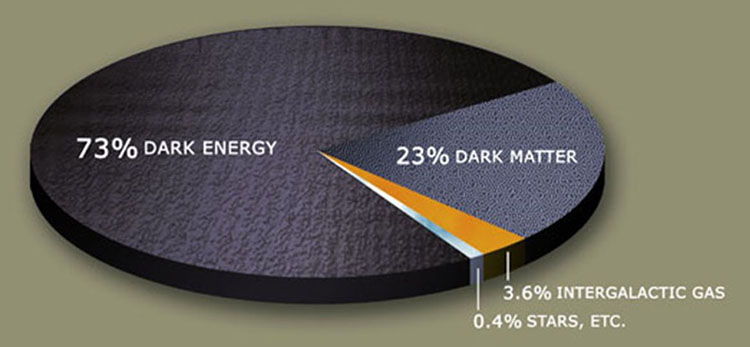
The inclusion of dark energy in the models is important, since we think that the present day universe is largely made of dark energy. However, we believe it was not as prevalent earlier in the universe, which was dominated by radiation, giving way to dark matter and normal matter.
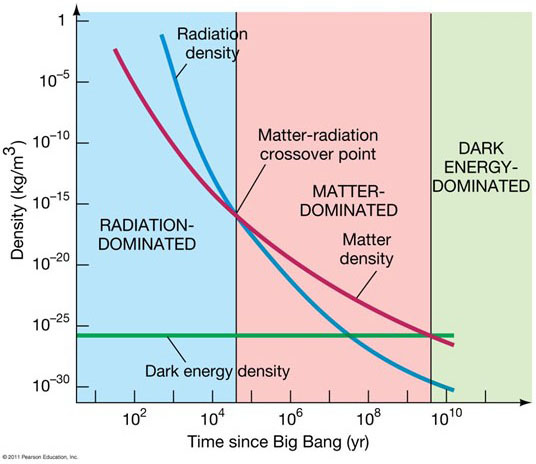
© 2011 Pearson Prentice Hall, Inc
This diagram illustrates the timeline for the radiation, matter and dark energy dominance in the universe. Radiation density dominates at early times but decreases more rapidly than matter density. The crossover point signifies the time when matter density began to dominate the universe. Notice that the dark energy density stays constant over time, even though the volume of the universe is expanding.
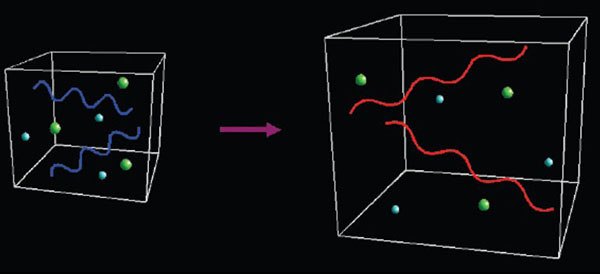
The idea here is that as the universe expanded, the density of matter decreased, since the matter was dispersed over a wider and wider region. The radiation energy density from light waves decreased as well, but it was also redshifted, so the radiation density decreased faster than the matter density. The matter-radiation crossover point on the timeline defines the point in time where matter began to dominate the universe.
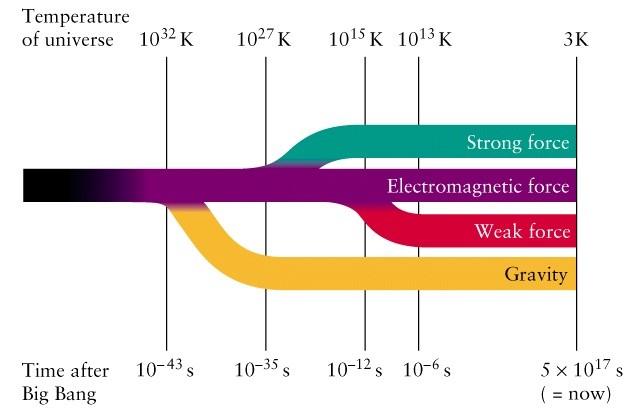
© 2011 Pearson Prentice Hall, Inc
This graphic illustrates the splitting of the forces in the early universe.
The earliest epoch of the universe is called the Planck epoch, named for our smallest unit of time, the Planck time, which is about 10-44 seconds. It is basically derived using constants of physics, including Planck's constant h. The Planck epoch ended when the gravitational force split off from the superforce; we call this epoch the Grand Unified Theorem (GUT) epoch. The strong nuclear force split off next, and then the electroweak force split into the electromagetic force and the weak force.
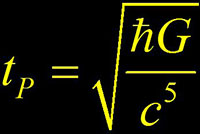
We can calculate the Planck time using the fundamental constants. h bar is the Planck constant (divided by two pi) G is the gravitational constant and c is the speed of light. It is a very small unit of time, useful in describing events that happened very quickly in the early universe. We theorize that it is the smallest possible time interval that can be measured, and can be used to describe quantum mechanical processes.

© 2011 Pearson Prentice Hall, Inc
-
Planck epoch
- First 10-43 seconds
- Temperature ~ 1032 Kelvin
- Quantum gravity
- One superforce
-
GUT epoch
- Gravity splits off
- Subatomic particles created
via pair production
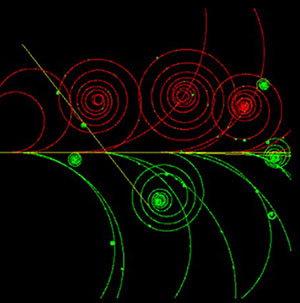
The Grand Unified Theory epoch followed the Planck epoch, characterized by the splitting off of the gravitational force. The combination of the general relativity and quantum mechanics is the hallmark of the grand unified theory. Many people have worked to try to unite these two theories into one, but no one has been able to successfully describe one theory that truly encompasses both.
By nature, general relativity, which deals with gravity, is a field theory, defined smoothly on manifolds, or surfaces. By nature, quantum mechanics is not continuous, but relies on inherent probabilities.
One of the basic premises of quantum mechanics is Heisenberg Uncertainty, the concept that the position and momentum of an object cannot be simultaneously know to any accuracy. The better you know where something is, the less you know about how fast it is moving.
The difference in the basic natures of general relativity and quantum mechanics is the main reason no one has yet to merge the two into one grand unified theory. There are some theories that work to include both, such as quantum gravity. Here, the "spiky" quantum mechanics is sewn onto the "smooth" general relativity.
In the GUT epoch, the first subatomic particles make their appearance, created via pair production from highly energetic photons.
-
Quark epoch
- Strong force frozen out
- Low-mass and high-mass particles in thermal equilibrium
- Electroweak force freezes out
- Inflation
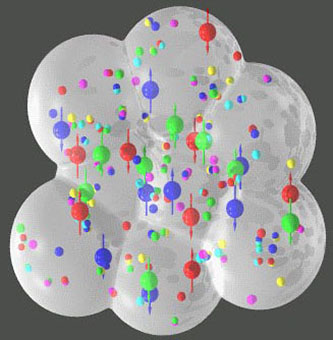
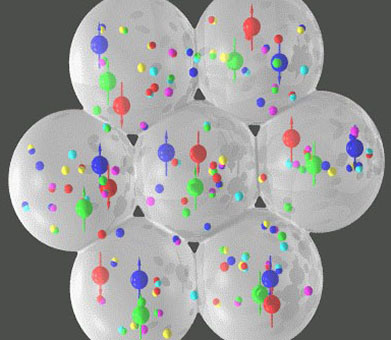
The quark epoch begins with the strong force being "frozen out" or separating off from the electroweak force. The strong force is responsible for quarks binding together into nucleons. When the strong force became frozen out, the matter transformed from a quark-gluon plasma (left diagram) into hadronic matter (right diagram), made of individual nucleons, each separately made up of quarks and gluons.
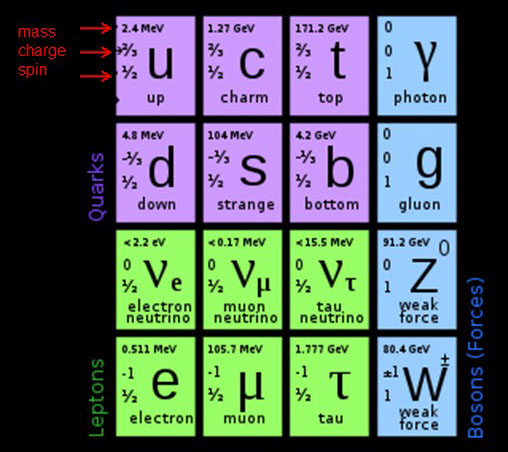
In the standard model of particle physics, particles are divided into categories including quarks, leptons and bosons. Leptons come in three types, including electrons, muons and taus, each with a corresponding neutrino. Also, each matter particle has an antimatter counterpart.
Protons and neutrons are composite particles, made up of quarks. A proton is made of two up quarks and a down quark, while a neutron is made of one up quark and two down quarks. Bosons are exchange particles, which mediate the forces. For example, photons mediate the electromagnetic force between charged particles.
For a nice introductory website on particle physics, please visit the Lawrence Berkeley Lab at www.particleadventure.org
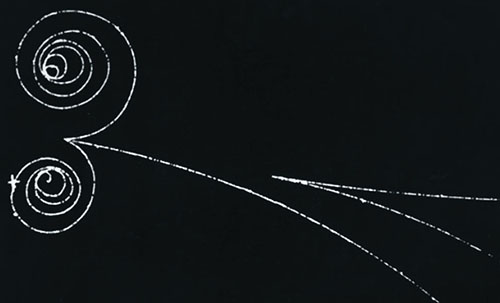
The image above is data from a cloud chamber experiment, showing the pair production of an electron (lower curl) and a positron (upper curl) from a gamma ray photon. The gamma ray photon enters from the left, and is unseen in this image; since it is not a charged particle it leaves no trail. The long arc curling down from the pair is a scattered electron in the water vapor of the cloud chamber. To the right is a more energetic electron-positron pair, with a shallower curve.
To produce an electron-positron pair, a photon must have the energy equivalence of the mass of both particles, calculated using E = mc2. A proton-antiproton pair of particles requires a much higher energy photon, since the masses of these particles is higher. The temperature corresponding to the lowest energy photons necessary for pair production of a given kind of particles is called the particle's threshold temperature. The threshold temperature for protons is 1013 K, while the less massive electrons only require about 6x109 K.
During the quark era, low-mass particles, like electrons and positrons, and high-mass particles, like protons and anti-protons were in thermal equilibrium. This means that the temperature was high enough, and the photons had high enough energy, that protons and antiprotons were being produced and annihilated at the same rate. As the universe expanded and cooled, the temperature fell below the threshold temperatures for protons. In the language of cosmology, protons and neutrons were frozen out of the radiation field when the temperature fell below 1013 K.
When the temperature fell below threshold temperature, there was slightly more matter than antimatter, by percentage, about one extra proton for every billion proton-antiproton pairs. This small percentage of particles makes up all of the protons in the universe today.
Also during the quark era, the electroweak force was frozen out. This happened when the W and Z particles were frozen out. Since they have higher mass than protons and neutrons, they froze out earlier, and at higher temperatures.
-
Lepton epoch
- Low-mass particles in thermal equilibrium
- Neutrinos decouple at 1010 K
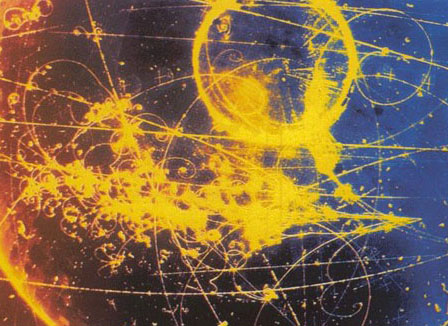
Leptons are fundamental particles, the most common of which are electrons. Electrons have much lower mass than protons and neutrons, so they remained in thermal equilibrium longer than the more massive particles. Electrons froze out of the radiation field when the temperature fell below their critical temperature of about 6x109 K. Neutrino masses are much smaller than electron masses, so they froze out of the radiation field at even lower temperatures.
- Nuclear epoch
-
- Fusion of deuterium and helium

© 2005 Pearson Prentice Hall, Inc
There are two kinds of electric charge, positive and negative. Protons are positively charged particles, while electrons are negatively charged, and neutrons are neutral, with no charge. Opposite charges attract, and like charges repel. Two protons approaching each other will repel each other more and more as they get closer.
Protons and neutrons are also affected by the strong nuclear force. The strong nuclear force is only attractive, and like it sounds, is much stronger than the electromagnetic force, but only over very small distances. If a proton and a neutron get close enough to each other for the strong force to dominate, they bind together to form a deuteron. If the temperature is very high, deuterons break up very quickly after being formed. As the temperature lowers, they tend to stay bound longer. When two deuterons approach each other, the positive charge of the protons repels them back apart. If they are moving fast, they can get close enough for the strong force to dominate and bind them together to form a helium nucleus though a couple of steps shown above.
The nuclear epoch is defined as the time when the temperature was right for atomic fusion to create nuclei. When the temperature was too hot, the energies were too high and particles either flew past each other for fusion to happen or nuclei broke up as quickly as they formed. When the universe cooled off to about 109 K, nuclear fusion took place, creating enough helium to account for about 25% of the matter in the universe, by mass. Since this fusion happened in the early universe, we call it primordial nucleosynthesis. The rapidly cooling universe soon fell below the lower threshold temperature for fusion, and fusion stopped. This window of opportunity for fusion only lasted an estimated 15 minutes.
Deuterium abundance
Not all of the deuterium formed during the nuclear epoch went into helium nuclei, some was left over. Deuterium formed in the cores of stars does not survive, so whatever deuterium we detect must be primordial. Comparing the amount of deuterium present with our estimate of how much there should be gives us a measure of the overall density of matter. According to this calculation, the density of matter is only a few percent of critical density. This does not, however, take dark matter into account.
We use a pencil-beam survey, which is a very high resolution, narrow focus image of the universe, to gain an understanding of the history of the universe. The larger the redshift of the object, the farther back in time the image. The highest redshift galaxies are very early in formation. Farther back in time, we would be able to see the first stars. Even farther back is an era we call the Dark Ages, because it is the time before the first stars formed, so there were no stars shining. Before that, was the age of recombination, when the universe cooled off enough for the first atoms to be formed (electrons bound to protons). At this time, the universe went from being opaque to transparent because only light of particular wavelengths interacted with atoms. The afterglow of the Big Bang is farther back in time, reflecting the Big Bang itself.